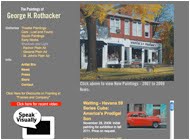18" x 24" Acrylic on Canvas
George H. Rothacker, 2011©
SOLD
Owned by Mr. and Mrs. William Martindale
Prints are available.
Please contact george@rothackeradv.com
Cuba developed a wide range of creolized musical styles, based on its cultural origins in Europe and Africa. Since the 19th century its music has been influential throughout the world. It has been perhaps the most popular form of world music since the introduction of recording technology.
Much of the music associated with Cuba today originated in, or was influenced by, other Latin America countries, and was performed in the nightclubs and social clubs of Havana between the 1930s and the 1950s.
Shortly after the Cuban Revolution in 1959, Cuban President Manuel Urrutia Lleó began closing gambling outlets, nightclubs and other establishment associated with Havana’s hedonistic lifestyle. This shift towards the left and an effort to build a “classless and colorblind” society had an immediate impact on the livelihood of entertainers and created a huge change in the musical environment. Although the Cuban government continued to support traditional music after the revolution, certain favor was given to the politically charged nueva trova, and poetic singer-songwriters of the time.
In the 1990s, an American guitarist Ry Cooder and Cuban musician Juan de Marcos Gonzalez teamed up with traditional Cuban musicians on a recording, “The Bueno Vista Social Club” to reawaken the music of the heyday of Cuba’s past and introduce the world to some of the music written by the local composers of the past. The album became a “word of mouth” success, sold five million copies and won a Grammy in 1998.
skip to main |
skip to sidebar

Havana '59 Exhibition and Sale at Eastern University - Opening - November 11, 2011
Presented by Eastern University, Friends of the Library, and Pennsylvania Trust to benefit the David R. Black Academic Enrichment Fund. Click here to for tickets to the November 11,2011 Grand Opening at the Bolingbroke Mansion in Radnor
Sponsers (to date): (click on link to view sponsors websites) Pennsylvania Trust, Corporate Dimensions, LTD., Handelok Bag Company, Edmar Abrasive Company, Franklin Mint Federal Credit Union, Newman & Saunders Galleries
Sponsers (to date): (click on link to view sponsors websites) Pennsylvania Trust, Corporate Dimensions, LTD., Handelok Bag Company, Edmar Abrasive Company, Franklin Mint Federal Credit Union, Newman & Saunders Galleries
Total Pageviews
Links to Paintings
- The Purple Caddy
- Cuban Cubism
- Street Art in Havana
- Hemingway on Patrol
- Havana Miniatures
- Parade Down the Malecon
- The Balcony
- Caught Dancing
- Horsepower
- Cruisin'
- Eve of Construction
- Passing through Old Havana
- Moko Jumbie
- The Castle
- Distant Beaches
- Hemingway Slept Here
- Shoring it Up
- Downtown Old Havana
- City of Contrasts
- Pretty in Pink
- Neglect
- The Ghosts of Old Havana
- A Man and a Woman
- Private Property
- Keepin' It Running
- The Lafayette Hotel
- Disappointment
- Washday Madonna
- Cuba: America's Prodigal Son
- The Sea Wall
- Hotel Nacional
- View from the Hotel Nacional
HAVANA '59 -The VIDEO
Click below to see more of George's Paintings
Biography of Artist

- George H. Rothacker
- Villanova, Pennsylvania, United States
- George Rothacker is a celebrated artist, filmmaker and designer who shares a long history with the Jimmy Stewart Museum, In 2002, he painted “First Snowfall,” a canvas and print edition featuring “It’s a Wonderful Life” on the marquee of the Indiana Theater. Over the years, his collaboration with the Museum has produced, among other things, the biographic documentary of Stewart: “Always Remember – Be Nice to People.” George and his wife, Barbara, live in Villanova, Pennsylvania and are parents to four children and grandparents to eight. George’s daughter, Noelle, graduated from Indiana University of Pennsylvania in 2002, and now lives with her family in the community of Penn Run, a short drive from the Stewart Museum.




